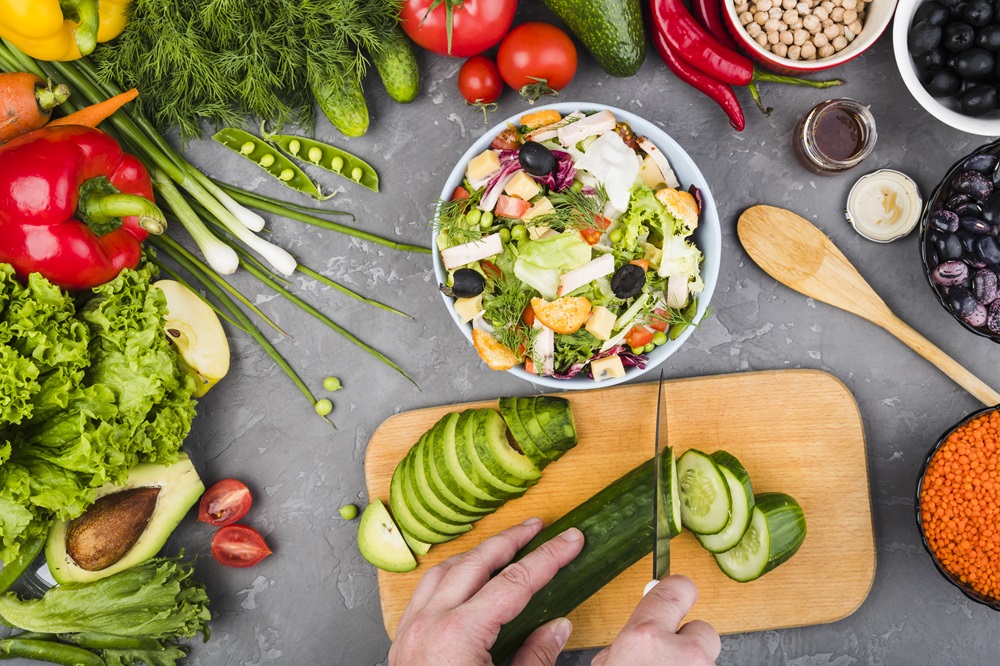Hashimoto Diet – Recipes, Recommendations, Meal Plan

Hashimoto’s is one of the most common autoimmune diseases, which can lead to the development of hypothyroidism. Following an appropriate diet for Hashimoto’s may be helpful for people struggling with the condition and may have a positive effect on their quality of life. What is autoimmune thyroiditis? Hashimoto’s - what to eat? Hashimoto diet - what to avoid? What effects can the Hashimoto diet bring?
Table of contents
- Hashimoto diet - what to eat?
- Hashimoto diet - allowed foods. What can you eat with Hashimoto’s?
- Hashimoto diet - what not to eat? Prohibited foods in the Hashimoto diet
- Hashimoto diet - vitamins and minerals
- Diet and medication interactions in Hashimoto’s disease
- Anti-inflammatory diet for Hashimoto’s - effects
What is Hashimoto’s?
Hashimoto’s disease, also known as autoimmune thyroiditis, is an autoimmune condition in which the body produces antibodies that attack the thyroid gland. In people with Hashimoto’s, elevated levels of anti-thyroid peroxidase antibodies (anti-TPO) and anti-thyroglobulin antibodies (anti-TG) are observed, which may lead to lymphocytic infiltration and destruction of the thyroid.
Hashimoto’s disease is one of the most common autoimmune disorders, and in developed countries it is also the most common cause of hypothyroidism. Hashimoto’s is diagnosed primarily in women, and available data suggest that autoimmune thyroiditis is most often detected in women between the ages of 30 and 50, with the risk of developing the disease increasing with age.
Causes and symptoms of Hashimoto’s disease
The development of Hashimoto’s disease may be influenced by both genetic predisposition and certain environmental factors, such as smoking, chronic stress, gut dysbiosis, or viral and bacterial infections.
Symptoms of Hashimoto’s are nonspecific and can affect the entire body. People with autoimmune thyroiditis most often report chronic fatigue, feeling cold, constipation, hair loss, and dry skin, as well as menstrual irregularities, concentration problems, and low mood.
Hashimoto diet - what to eat?
Treatment for Hashimoto’s includes taking appropriate medications prescribed by a doctor, as well as changing lifestyle and daily eating habits. What type of diet is recommended for Hashimoto’s?
There is no single eating plan that would be recommended for all people with autoimmune thyroiditis. The Hashimoto diet should be tailored individually to the person with the condition, while following the principles of healthy eating, being properly balanced, and rich in valuable nutrients.
Because Hashimoto’s is an autoimmune disease associated with immune system dysfunction and inflammation in the body, it is usually recommended to follow an anti-inflammatory diet, which provides foods with immune-modulating potential.
Hashimoto diet - allowed foods. What can you eat with Hashimoto’s?
The basis of the Hashimoto diet should be vegetables and fruits, primarily in unprocessed form, though cooked and fermented forms are also allowed. In addition, the diet should include whole-grain products, such as coarse groats (e.g., buckwheat) or wholemeal pasta, as well as dry legumes. The Hashimoto diet should also feature plant-based fats in the form of vegetable oils, such as flaxseed oil or olive oil, as well as seeds (e.g., pumpkin seeds), kernels (e.g., sunflower seeds), and nuts (e.g., Brazil nuts).
It is also worth paying attention to the consumption of fish, especially fatty sea fish, such as salmon, tuna, or mackerel, as well as seafood. The menu can also include lean meat and low-fat milk and dairy products.
Hashimoto diet - what not to eat? Prohibited foods in the Hashimoto diet
In the Hashimoto diet, as in the DASH diet or a classic healthy eating plan, it is recommended to limit animal-based products. In particular, it is advisable to reduce the consumption of fatty meats, such as pork, beef, duck, or lamb, and to eliminate offal, bacon, and lard. Palm oil, lard, and high-fat dairy products — especially cream and aged cheeses — are also not recommended.
The Hashimoto diet should limit simple sugars and exclude highly processed foods. Carbonated drinks, alcohol, salty snacks, and fast food are also discouraged. Furthermore, it is worth reducing the intake of foods containing goitrogens — compounds that can interfere with iodine absorption and increase iodine excretion from the body. Rich sources of goitrogens include soy products, as well as broccoli, cauliflower, and cabbage family vegetables.
When looking for information about the Hashimoto diet, you may often come across claims that gluten and lactose should be eliminated. Although lactose intolerance and celiac disease can occur in people with Hashimoto’s, recent scientific research indicates that gluten and lactose should not be excluded without a confirmed diagnosis of these conditions. Therefore, Hashimoto’s disease alone is not a reason to eliminate gluten or lactose from the daily menu.
Hashimoto diet - vitamins and minerals
Although the diet recommended for Hashimoto’s does not differ significantly from general healthy eating principles, there are certain nutrients worth paying special attention to when planning an anti-inflammatory diet:
- Iodine – essential for proper thyroid function. Both deficiency and excess of iodine can disrupt thyroid activity, so it is important to monitor intake and levels regularly. Sources include fatty sea fish, seafood, and iodized table salt.
- Zinc – involved in thyroid hormone production, and deficiency can negatively affect gland function. Sources include eggs, nuts, and chicken meat.
- Vitamin D – a fat-soluble vitamin that supports proper immune function. Studies suggest that supplementing vitamin D may help reduce anti-TPO antibody levels. Sources include fatty sea fish.
- Selenium – has anti-inflammatory and antioxidant potential and supports proper thyroid function. Data suggest that women with Hashimoto’s have lower selenium levels than healthy women. Sources include Brazil nuts, eggs, and seafood.
- Omega-3 fatty acids – such as EPA and DHA, which may have anti-inflammatory properties, helping reduce inflammation and support the immune system. Sources include fatty sea fish and microalgae.
Diet and medication interactions in Hashimoto’s disease
People with Hashimoto’s usually take doctor-prescribed medication alongside diet changes. For treatment to be effective, it is important to consider possible interactions between food and medication.
Whole-grain products, which are rich in fiber, can interfere with medication absorption, so it is recommended to eat high-fiber foods at least one hour apart from medications. Soy products and coffee may have similar effects – these should also be consumed with a time gap from medication.
Papaya fruit may negatively impact drug absorption, so its intake should be limited. Calcium supplements and iron preparations can also reduce treatment effectiveness, so a 2–4-hour gap between them and medication is recommended.
Vitamin C and foods rich in ascorbic acid may improve the bioavailability and absorption of medication used in Hashimoto’s disease.
Anti-inflammatory diet for Hashimoto’s - effects
Lifestyle changes, a healthy and balanced diet, proper supplementation, and taking prescribed medications as directed by a doctor may improve quality of life for people with Hashimoto’s disease.
Including anti-inflammatory diet principles in your daily menu may help alleviate unwanted symptoms and make daily life easier. Furthermore, regular monitoring of the condition and following medical recommendations can help control and reduce body weight.
Hashimoto diet - sample meal plan A Hashimoto-friendly meal plan should be based on healthy eating principles and include foods with anti-inflammatory properties. People with autoimmune thyroiditis should consult an experienced dietitian to tailor their menu to individual preferences and needs. Here is an example of a Hashimoto diet menu:Breakfast - colorful oatmeal
Ingredients: 200 ml of 1.5% milk, 40 g of rolled oats, a handful of blueberries, half a banana, 1 tablespoon peanut butter, 1 teaspoon chia seeds.
Preparation: Pour the milk into a small pot, add oats, and bring to a boil. Remove from heat, cover, and let sit for a few minutes to soften. Transfer the oatmeal to a bowl. Add peanut butter, washed blueberries, and sliced banana. Sprinkle with chia seeds.
Second breakfast - vegetable-fruit smoothie
Ingredients: a handful of fresh spinach, 1 celery stalk, 1 apple, 1 pear, juice from half a lemon, water.
Preparation: Wash all produce. Place spinach in a blender, add finely chopped celery, peeled and chopped apple and pear. Pour in lemon juice and a bit of water. Blend until smooth. Add more water if needed.
Lunch - baked salmon on rice with beet salad
Ingredients: 150 g salmon fillet, 50 g brown rice, a handful of cherry tomatoes, juice from half a lemon, 4 slices of lemon, favorite spices, a handful of arugula, 1 beet, a slice of feta cheese, 3 tablespoons rapeseed oil.
Preparation: Remove the salmon skin, wash, dry, and cut the fish into smaller pieces. Season with spices and drizzle with lemon juice. Cook the rice according to package instructions. Place the cooked rice in an oiled baking dish. Arrange salmon pieces and washed, halved cherry tomatoes on top of the rice. Add lemon slices next to the tomatoes. Drizzle with oil and sprinkle with spices. Bake for 15-20 minutes at 200°C (392°F). Meanwhile, prepare the salad - wash and dry arugula, place in a large bowl. Cook and peel the beet, then dice and add to the arugula. Dice feta cheese and add to the bowl. Drizzle with rapeseed oil and mix.
Afternoon snack - fruit salad with natural yogurt
Ingredients: 1 banana, 1 apple, 1 kiwi, 1 pear, 3 tablespoons natural yogurt, a handful of Brazil nuts, 1 teaspoon flaxseed.
Preparation: Wash, peel, and dice the fruit. Place in a bowl. Add yogurt, Brazil nuts, and flaxseed. Mix everything together.
Dinner - buckwheat crepes with avocado
Ingredients: 1/2 cup buckwheat flour, 1 egg, 1/2 cup water, 1/4 cup milk, 3 tablespoons rapeseed oil, a pinch of salt, 1 tomato, 1 avocado, a handful of fresh spinach.
Preparation: Place all ingredients in a large bowl and blend until smooth. Heat a crepe pan and pour small portions of batter. Flip after one minute. Remove the golden crepes from the pan. For the filling - wash, peel, and dice the tomato. Cut the avocado in half, remove the pit, peel, and dice the flesh. Place in a bowl with washed spinach. Mix ingredients. Spoon the filling onto the crepes and roll them up.
Bibliography:
- https://ptfarm.pl/pub/File/Bromatologia/2015/nr%202/Bromatologia%202_2015%20s_%20117-127.pdf
- https://journals.viamedica.pl/forum_zaburzen_metabolicznych/article/view/56317
- https://pubmed.ncbi.nlm.nih.gov/31275780/
- https://pubmed.ncbi.nlm.nih.gov/30208979/
- https://pubmed.ncbi.nlm.nih.gov/32588591/
- https://pubmed.ncbi.nlm.nih.gov/31071734/

